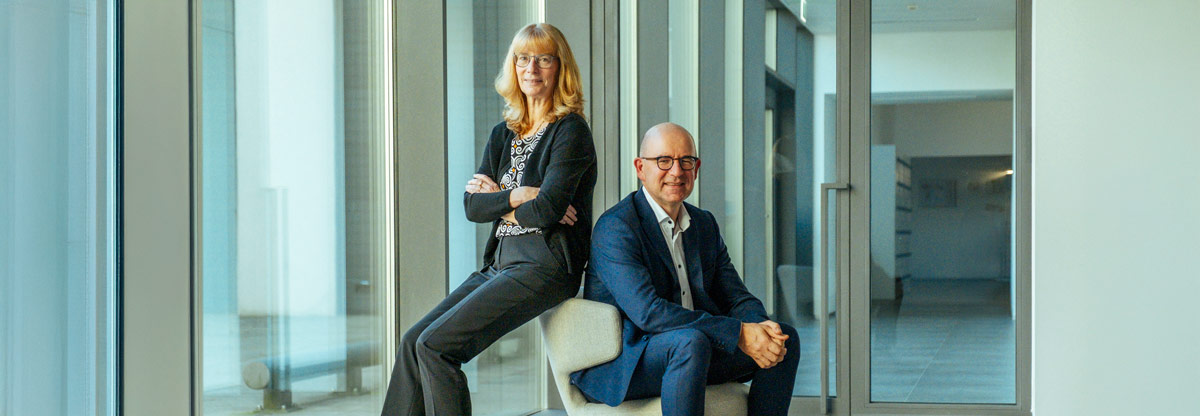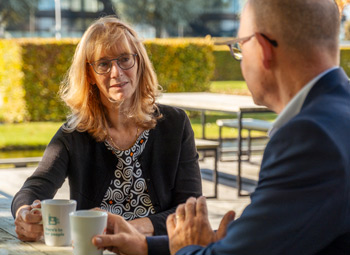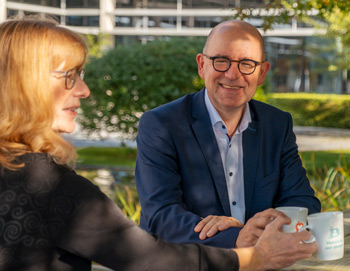
Good supply chain planning has become a matter of survival
November 13, 2024
Double interview with Anita Van Looveren and Paul Vanvuchelen. Translated from Trends (in Dutch).

A change of leadership at OMP, a Flemish world leader in supply chain planning solutions. After more than 25 years, Anita Van Looveren is stepping down as CEO to become Chair of the Board, with OMP veteran Paul Vanvuchelen taking over as CEO. "We want to continue our growth. Supply chain planning is now a hot topic in the boardrooms of major companies. Good planning has become a matter of survival," say Anita Van Looveren and Paul Vanvuchelen.
Which product should we make in which of our 300 factories? This is one of the millions of planning questions that Nestlé has to answer daily. Recently, the Swiss food giant has turned to OMP’s planning software, a Flemish world leader that helps businesses organize their supply, production, and logistics optimally. "During COVID, demand initially dropped and then rebounded unexpectedly quickly. Post-COVID, companies have realized that this volatility is the new normal. Demand, supply, supply routes, prices, and margins are changing faster than ever. Expect the unexpected. Companies that can respond quickly have a significant advantage. Companies with a strong planning culture are best equipped to withstand the storms. Planning is hot in the boardrooms of major companies. Good planning has become a matter of survival," says new CEO Paul Vanvuchelen.
OMP was founded in 1985 by Professor Georges Schepens as an academic spinoff. “I was OMP’s first consultant. We wanted to help companies solve complex planning problems using smart planning algorithms. We never thought it would grow so quickly," reflects Anita Van Looveren on the early years. Over 40 years later, OMP is a world leader with a turnover of €220 million, a net profit of €33 million (in 2023), a team of more than 1,200 people, 10 offices worldwide, and renowned multinationals like Nestlé, Johnson & Johnson, and Bayer as major customers. Since becoming CEO in 1994, Anita Van Looveren has been the architect of this success. “Georges Schepens’ decision to step down as Chair also made me reflect. It’s time. Starting November 1, I’ve exchanged my CEO role for that of Chair."
 Will you be an active Chair?
Will you be an active Chair?
Yes, indeed. In the coming months, I’ll be working closely with Paul to ensure a smooth transition. After that, my focus will gradually shift to my strategic role as Chair. I’ll also stay involved in some new and strategic projects. To fulfill the Chair role effectively, you need to stay close to the organization."
How do you look back on 40 years at OMP?
“I think we can be proud of what we’ve achieved, starting with a very small team in the late ’80s. Without false modesty, we can say that we deliver top quality to renowned global clients. Serving clients has always been our passion. It remains the DNA of the company today. We’ve managed to keep our original drive and dynamism."
How challenging was it for you as CEO to grow from a small company into a global player with 1,200 employees?
When you’re in the thick of it, you might not notice, but I’ve reinvented myself multiple times. I started as OMP’s first consultant, back when we didn’t have any customers. There was only a first version of a product, and no documentation. So, I was a jack-of-all-trades for the company. Later, I began managing small teams and still worked on projects. At a certain point, that wasn’t possible anymore, and I had to choose. I chose to build the organization and – with a heavy heart – let go of project work. But it’s also very rewarding to see the company grow and thrive."
Mr. Vanvuchelen, could you introduce yourself?
“I initially worked for 13 years at the steel company Aperam, a major OMP customer. We implemented OMP’s software, and I felt a connection with the company. I’ve now been with OMP for 12 years, most recently responsible for customer deliveries. At OMP, we have two groups: people who develop the software and those who sell and deliver it."
"We value delivery highly, which is part of our success. A customer buys trust from us. You must deliver what you promised in terms of quality and lead time. We actually ‘marry’ our customers for life. Our customer turnover is very low, especially compared to competitors."
What is your management style?
 “I come from youth organizations and soccer. I believe strongly in teamwork, but you play to win. Consider each other. If the player in front of you doesn’t like defending, then you defend a little more. That team spirit mustn’t disappear here. As a soccer captain, I learned that you improve by strengthening each other. Nagging at each other and hoping things improve doesn’t work. Sometimes, management makes inconsistent decisions just to squeeze out an extra 1% profit in the short term. This can backfire. It creates a lot of unhappiness, though the shareholder won't feel the impact on their bottom line. You can't win a game if you have 11 players on the field who don’t really want to be there.
“I come from youth organizations and soccer. I believe strongly in teamwork, but you play to win. Consider each other. If the player in front of you doesn’t like defending, then you defend a little more. That team spirit mustn’t disappear here. As a soccer captain, I learned that you improve by strengthening each other. Nagging at each other and hoping things improve doesn’t work. Sometimes, management makes inconsistent decisions just to squeeze out an extra 1% profit in the short term. This can backfire. It creates a lot of unhappiness, though the shareholder won't feel the impact on their bottom line. You can't win a game if you have 11 players on the field who don’t really want to be there.
We build our customer relationships with a long-term perspective. When challenges arise, let's talk and find a solution together. The spirit of collaboration is far more important than the fine print in the contract. After tough negotiations, we honor the agreements, and rarely, if ever, do we need to pull out the contract later. Customers can sense when you’re genuinely working together to find solutions.
Does the leadership change mean a change in strategy?
Anita Van Looveren explains: “No. We want to continue the growth we’ve achieved in recent years, aiming for an annual revenue increase of 10 to 15 percent. This isn't wild growth, but rather realistic and sustainable. Our global customers, who initially operated mainly in the US and Europe, are now expanding to the rest of the world. We want to follow their lead, positioning ourselves more as a global player with a sharper focus on growth markets in Asia, Latin America, and Australia. We’re a global player with a local presence. Expanding to regions like China or Australia requires building capacity on the ground. We now have around ten offices worldwide. This strategic choice was made independently of the CEO transition. We're also expanding our service offerings. In recent years, we’ve focused on implementing our software, though we also have the expertise to offer advisory services. That's why we've asked Paul to put consulting back on the map.”
Can you announce new major customers soon?
"Yes, both within and outside Europe. Each year, we bring in two or three very large customers, along with a host of smaller customers. But it depends on what you consider small—those smaller customers used to be our major ones. "
"In the past, a project would take around 20 to 50 days to complete; now we're talking about projects that span thousands of days.”
With the company’s growth, will the organizational structure adapt?
“We’re in a phase where changes are necessary. In smaller organizations, communication was easier; you could shout something and everyone would hear it. We’re shifting from a consensus model to a consent model. We’re creating leadership teams with clear mandates. Currently, too much still goes through the CEO."

Will the shareholder structure remain the same, with 80% held by management and employees and 20% by investment firm Ackermans & van Haaren?
“For the foreseeable future, yes. About 15% of employees are shareholders, which motivates them to put their heart and soul into the company. Ackermans & van Haaren, which shares our values and provides valuable input, is also committed for the long term. We have no plans for a stock market listing. We’re profitable and can finance our growth independently. We have no debt because we’ve never made large acquisitions."
Can we expect consolidation in your market?
“There has been some consolidation recently, with smaller players exiting. Our market still has ample potential for organic growth. We maintain our focus on six industries, including consumer goods and life sciences. Industry knowledge is essential to quickly implement a solution for a customer. We’re building a partner network to help meet demand when we lack capacity. We outsource complementary tasks to partners. In the meantime, we have a strong network, including partners who help us integrate new technologies. You can’t do everything yourself. These partnerships may eventually lead to financial participation in a partner. We’re big enough to do that."
Are investors interested in acquiring or taking a stake in your company?
“We get a lot of emails, but we send back a standard response."
How does artificial intelligence impact your business?
“Artificial Intelligence is our business. We’ve long used algorithms to solve complex planning issues, but the possibilities are growing. For instance, a model might generate solutions that a business planner doesn’t fully understand. AI helps explain these solutions, boosting the planner’s confidence in the model. A chatbot even enables the planner to interact with the model."
Who is still making the plans: the computer or the human? Are managers still needed to run a company operationally?
“Humans are certainly not redundant. As long as decisions need to be made, managers and planners are necessary.”
"Systems are becoming increasingly autonomous, but we are not moving toward 100 percent autonomy. We are heading toward smart autonomy, with a layer of human creativity and decision-making power on top. The computer can make suggestions, but it is still the manager who must decide based on the presented scenarios. This greatly lowers the barrier to access very complex connections and vast amounts of data. This is necessary, as complexity has increased tremendously and the economy has become much more volatile. Recently, I was with a client in Singapore. In the past, it took them half a year to properly map out all scenarios. Now, they can calculate a scenario in half an hour. This allowed them to present a ten-year, $500 million investment program to the board. In a complex world, you need to be able to adapt quickly and quickly calculate the impact of changes. For our business, this is, of course, a positive thing. That’s why our favorable growth prospects are also realistic."
